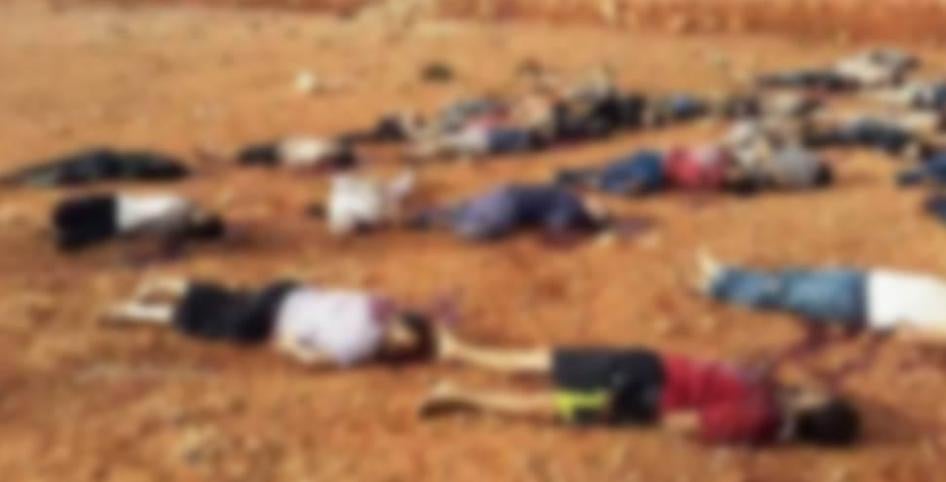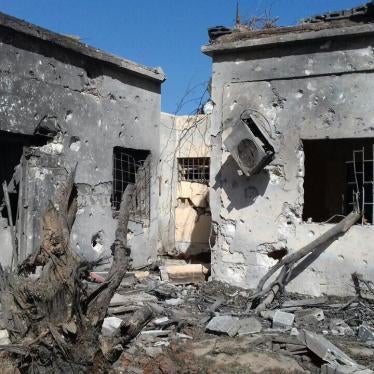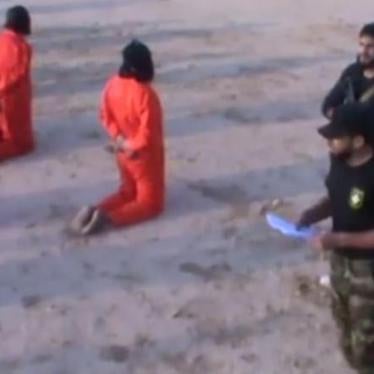(Geneva) – Armed groups loyal to Libyan National Army forces (LNA) appear to have summarily executed dozens of men in the LNA-controlled town of al-Abyar, Human Rights Watch said today.
On October 26, 2017, local police forces discovered the bodies of 36 men, all of them executed, close to a main road south east of al-Abyar, 50 kilometers east of Benghazi. Authorities transferred the bodies to a hospital, where families came to identify them. Relatives of six of the victims told Human Rights Watch that the men had been arrested on various dates by armed groups loyal to the LNA in Benghazi or in other areas controlled by the LNA.
This incident comes after a series of unlawful killings and summary executions in Benghazi that prompted the International Criminal Court (ICC) prosecutor to issue an arrest warrant against an LNA special forces commander on August 15.
Following the discovery of the 36 bodies in al-Abyar, Gen. Khalifa Hiftar, the LNA chief, ordered the military prosecutor of the eastern region on October 28, to conduct an investigation . The LNA and the military prosecution have yet to announce any investigation results.
“The Libyan National Army’s pledges to conduct inquiries into repeated unlawful killings in areas under their control in eastern Libya have so far led nowhere,” said Eric Goldstein, deputy Middle East and North Africa director at Human Rights Watch. “The LNA will be condoning apparent war crimes if their pledge to investigate the gruesome discovery in al-Abyar proves to be another empty promise.”
Human Rights Watch met with relatives of two of the victims in Tripoli and interviewed relatives of four others by telephone in October and November. All of them said that their family member had been arrested earlier in 2017, some only two days before the bodies were found, and had not been heard from again.
All said their relative bore one or more gunshot wounds, and that their hands were tied behind their backs, based on information they obtained from family members who identified the bodies at the Benghazi Medical Center, also known as Hospital 1200. Most interviewees did not have access to a medical report. All relatives also said that armed groups from Benghazi prevented families from putting up tents in front of their Benghazi homes to receive guests during the traditional three-day mourning period.
The relatives said that all six victims were civilians seized from their homes, in the presence of their families, by armed groups linked with the LNA. None of the armed groups presented an arrest warrant. Human Rights Watch reviewed multiple lists containing a total of 25 names of the men found at al-Abyar, but could not verify which were civilians and which, if any, were fighters affiliated with forces opposing the LNA.
Human Rights Watch also reviewed photographs of the bodies, including two apparent group photos of the victims, posted on social media sites by unidentified sources on October 26. The group photos show at least 35 bodies in an open field. Researchers also reviewed close-up photos of 23 of the victims and corroborated them with the group photos and with photos sent by relatives.
Most of the 23 victims photographed in close-up had their hands tied behind their backs with plastic handcuffs. Each was lying in what appeared to be a pool of blood. The majority had visible gunshot wounds to the head, neck or face.
Stefan Schmitt, a forensic investigator who reviewed the photos, said the injuries were consistent with executions at point blank range at the location where the bodies were discovered. The bodies appeared not to have been disturbed between the time of execution and the time of discovery. He said the photos were most likely taken within several hours of the killings, as the blood appeared not to have fully congealed.
The al-Abyar police chief, Col. Jalal al-Huweidi, spoke with Human Rights Watch by phone on November 27. He said that all 36 bodies were found at the same spot in al-Kassarat, a desert area southeast of al-Abyar. He said that his forces were alerted to the presence of the bodies, all of the people executed at the same spot, and had found them at around 1:30 p.m. on October 26. He said his forces, together with the Red Crescent, removed the bodies and transferred them to the hospital in Benghazi known as 1200, after the criminal investigation department and the attorney general’s office investigated the crime scene.
Human Rights Watch met with al-Siddiq al-Sur, head of investigations at the General Prosecutor’s office in Tripoli, on October 28, who said that 35 bodies were discovered in the location in al-Abyar and one more in the al-Qwarsha area in Benghazi. Al-Sur said his office had opened an investigation into the al-Abyar killings and was in contact with the Benghazi attorney general about it.
Armed conflict, insecurity, and political divisions have plagued Libya since May 2014, when General Hiftar declared war on “terrorism” in Benghazi and announced his Operation Dignity. As part of this operation, LNA-aligned forces battled fighters affiliated with the extremist group Islamic State (also known as ISIS), which has since withdrawn from Benghazi, and an alliance of militias and individuals known as the Benghazi Revolutionaries Shura Council (BRSC). Armed groups loyal to the LNA control large swathes of eastern Libya, with the exception of Derna, and some parts of the south.
Forces aligned with the LNA include regular army units, army special forces, neighborhood militias known as Sahawat, and a militia known as the Avengers of Blood or Katibat Awliya’ al-Dam, whose family members were killed fighting “terrorists” in Benghazi. Some LNA units include adherents of the strict Salafist Madakhla ideology that view Hiftar as their “ruler” to whom they owe “obedience.” On July 5, Hiftar announced the complete “liberation” of Benghazi from holdout elements of the BRSC, although fighting in the city’s downtown area of Sidi Khreibish continued until early November.
As a result of armed conflicts in both eastern and western Libya, central authority collapsed and three competing governments emerged, now reduced to two. These are the Interim Government based in the eastern city of al-Bayda, which is aligned with the LNA and supported by the House of Representatives, and the UN-backed, Tripoli-based Government of National Accord. Key institutions, most notably law enforcement and the judiciary, are dysfunctional in most parts of the country, and basic services have collapsed.
All parties to a conflict are required to abide by the laws of war. Certain serious violations of the laws of war, when committed with criminal intent, such as executions of civilians or enemy fighters who had been captured or had surrendered, are war crimes. Anyone who commits, orders, or assists, or has command responsibility for war crimes, can be prosecuted by domestic or international courts. Commanders may be criminally liable for war crimes of their subordinates if they knew or should have known of the crimes and failed to take measures to prevent them or hand over those responsible for prosecution.
“Senior army commanders who do not act resolutely to stop gross violations in areas under their control, and hold those responsible to account, should face criminal prosecution for complicity in war crimes,” Goldstein said.
The Families’ Accounts
Human Rights Watch researchers interviewed family members of victims of the al-Abyar incident between October 28 and November 13, in person in Tripoli, as well as by phone.
Ayman al-Sahati, who met with Human Rights Watch in Tripoli on October 28, said his brother Ahmed al-Sahati, 42, who was married with four children, was detained late on the night of October 25 by a large group of masked, uniformed men who stormed the family home in al-Laithi district in Benghazi, shouting, “We are looking for Ahmed.” The family spent the next day looking for him at militia and armed forces camps around Benghazi. Ayman said:
The minute my brother Ahmed walked down the stairs to the first floor after hearing the commotion, the uniformed fighters jumped on him and started kicking him and beating him with the butts of their weapons. My father demanded to know, “Who are you? Where are you taking him? What did he do?” One responded, “We are the army,” another said, “We are from internal security.” The fighters who remained outside of the house were shooting in the air.
We didn’t hear from Ahmed until his photo showed up among the 36 dead in al-Abyar. A relative who went to the hospital to identify him told us he saw a gunshot wound to the head and some torture marks. My brother was a civilian and not a fighter. He did not participate in the 2011 revolution, or fight in the conflict that started in 2014. In order to be able to live in Benghazi, you have to be a part of them [LNA] – or else.
Human Rights Watch met on October 30 in Tripoli with a relative of another al-Abyar victim, Hatem al-Oreibi, 32, who was married with two children. The relative, who asked to remain anonymous, said that al-Oreibi was one of two brothers arrested on September 9 at about 4 a.m., at their family home in al-Laithi district in Benghazi. The other brother, Imad al-Oreibi, 39, also married with two children, was still missing.
The family searched for the two brothers unsuccessfully in all known prisons, military camps, and militia headquarters around Benghazi. Family members made contact with the investigation and arrest apparatus linked to the LNA central command, under the control of Brig. Gen. Aun al-Farjani, and were told that the brothers were in a safe place, that they would be interrogated and then released. After some weeks, however, al-Farjani stopped responding to inquiries from the family. Hatem’s relative said:
Two family members who went to the morgue to identify Hatem and perform the traditional Muslim cleansing of the body before burial said that Hatem had multiple gunshot wounds to the head and thigh, and that some of his ribs were broken. They said that his hands were broken and the joints of his arms were dislocated. My two brothers, Hatem, who is now dead, and Imad, who is still missing, were not fighters. No one in our family fights with Hiftar, and now we are accused of being with “Daesh” [Islamic State] and against Hiftar.
In a follow-up call on November 21, the relative said that he had filed a complaint at the General Prosecutor’s office in Tripoli on November 14. He said the family had heard through personal contacts that Imad was at Kweifiyah prison in Benghazi, but that three days after the killing of Hatem and the others in al-Abyar, he was moved to an unknown location. Given their fear of reprisals, he said, the family decided to flee Benghazi and sell their home there.
Human Rights Watch spoke by phone on October 31 with a relative of another al-Abyar victim, Ali Rheil al-Werfalli. The relative asked to remain anonymous for fear of reprisals. He said a mixed group of LNA members, one member of the Salafist Madkhali militias, and armed men from the neighborhood forced their way into the family home in al-Laithi neighborhood at 3 a.m. on September 7, 2017. They detained al-Werfalli, an unmarried 29-year-old nurse, who was still wearing his swimming trunks from a visit to the beach earlier in the day. The family heard through personal contacts that he was being held at Kweifiyah Prison in Benghazi but was unable to confirm this. The relative said:
During the arrest, Ali’s mother asked, “Where are you taking him?” One of the armed men responded, “None of your business. If he didn’t do anything, then there is no problem.” The family heard nothing about him until he was found dead in al-Abyar. Two relatives who went to the hospital in Benghazi said that he was still wearing the same shorts he was arrested in, and that his head was split from the back. They also saw a burn mark on the left shoulder as they prepared the body for burial.
The death certificate stated that the cause of death was a 9mm gunshot wound to the back of the neck, and that the perpetrator was “unknown.” The relatives, who also saw the bodies of other victims, said some appeared to have bite marks from stray dogs…. Ali was not a fighter, but he was against this [LNA] Dignity Operation, and he was religious, which made the armed groups suspicious of him.
The relative also said that members of the Avengers of Blood militia warned the family against holding a traditional three-day mourning ceremony.
Abd al-Salam al-Tarhouni, 37, married with two children, another victim, was seized from his family home in al-Laithi, on September 15 at 3 a.m., said his brother-in-law, Ahmed Khalifa, who spoke with Human Rights Watch by phone on November 13. He said a masked armed group forcibly entered the family home in Benghazi asking for Abd al-Salam. They identified him and took him to an undisclosed location. Khalifa said:
When the news of the al-Abyar killings became known, Abd al-Salam’s father asked two relatives to go to the morgue to check if Abd al-Salam was among the dead. The relatives found him there, wearing the same clothes as when detained. They said he looked emaciated. When they prepared him for burial, they saw one gunshot wound to the forehead, one in his leg, and a third in the shoulder that had caused the bones to shatter. Abd al-Salam was not a fighter. He did not participate in the 2011 uprising or the conflict that started in 2014.
Khalifa said that once the family heard the news, they opened their house to mourners. Half an hour later, armed gunmen from their neighborhood who were loyal to the LNA descended on the house, which was full of people, including women and children, shooting in the air outside and shouting, “This is a Daesh house, this is the home of a terrorist. You are not allowed to mourn him. We are giving you a few minutes to empty the house.” The family left the house after this incident and has not returned, fearing reprisals.
On November 13, Human Rights Watch spoke by phone with a relative of two brothers who were among the al-Abyar victims, Naji al-Zayani, 43, and Nasser al-Zayani, 46. Both were detained on October 25, at 2 a.m., by armed masked men in a convoy of seven or eight cars who broke down the outer door of the family home in al-Muheishi area in Benghazi. The family had no news of them until they were found among the al-Abyar victims. The relative said:
During the violent arrest, one of the wives of the two men asked the forces where they were taking them. One of them raised his weapon and told her, “We will shoot you.” They took both men still wearing the sweat suits they slept in. The forces, who refused to identify themselves, took the mobile phones of the two brothers and of one of the wives. When family members went to the morgue to identify the two men, they were allowed to see only their faces. Family members of another victim told us that the two brothers were arrested by an LNA-linked armed group known as Tareq Bin Ziad. Neither of the brothers participated in the 2014 conflict. But the family is known for not supporting Hiftar and the LNA.








